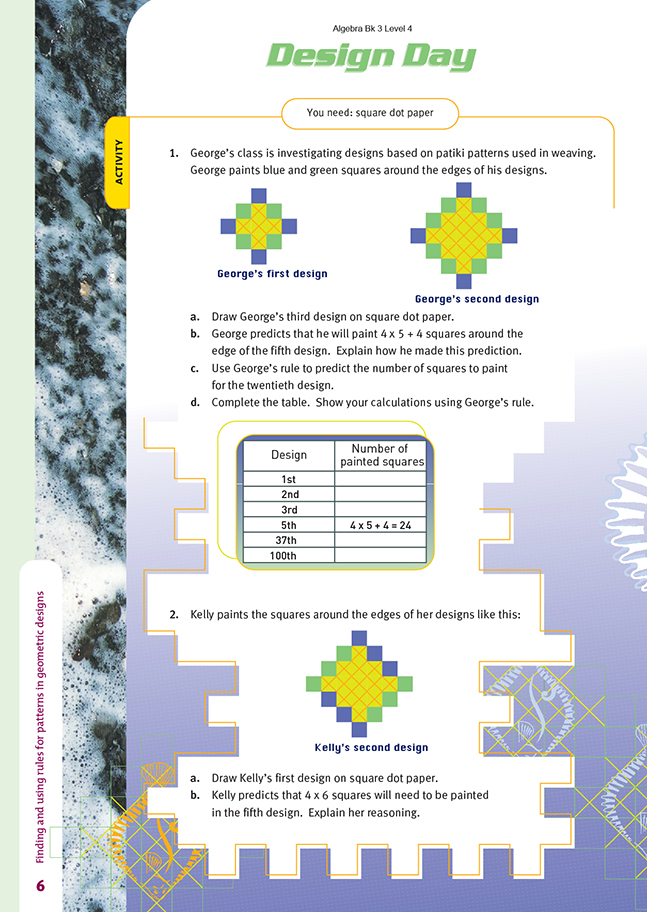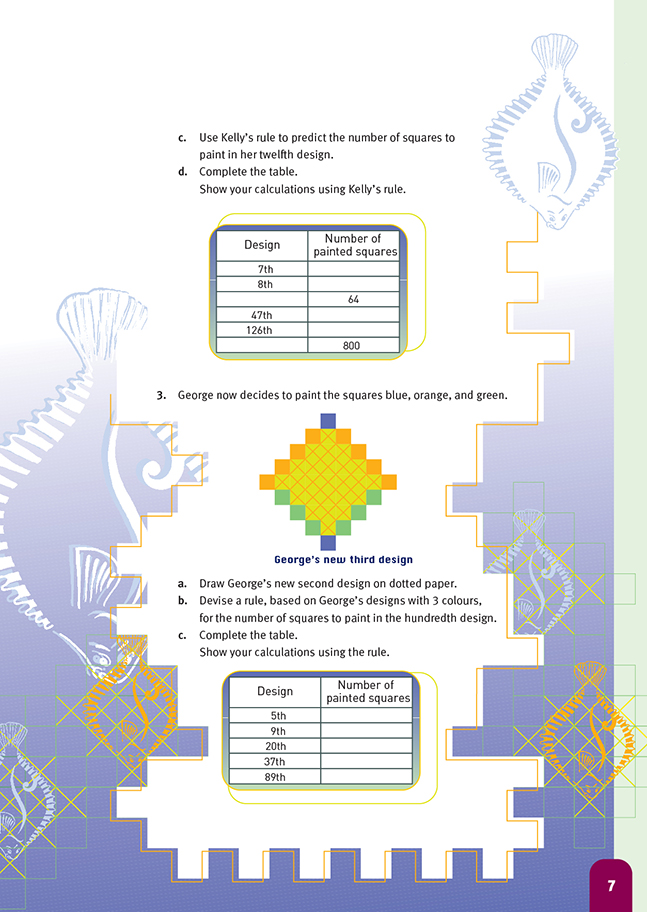This is a level 4 algebra strand activity from the Figure It Out series.
A PDF of the student activity is included.
Click on the image to enlarge it. Click again to close. Download PDF (292 KB)
complete a table to find a pattern
use a linear equation to describe a relationship
square dot paper (see copymaster)
FIO, Level 4, Algebra, Book Three, Design Day, pages 6-7
In this activity, students identify, use, and explain rules based on different patterns of colour for the number of squares on the edge of designs that are based on patiki patterns.
In question 1, George’s designs have changing numbers of green squares. Short cuts and rules for these and the others in this activity are given in the Answers.
Students who successfully complete the table in question 1d might see if they can write an algebraic expression for the number of painted squares in any of George’s designs. For example, the xth design will have 4 sets of x green squares and 4 blue squares. So the number of painted squares, y, in the xth design is y = 4 x x + 4 or y = 4x + 4. The thousandth design will therefore have 4 x 1 000 + 4 = 4 004
painted squares.
In question 2, Kelly uses a different pattern for her painted squares. Students using algebra to write a rule for Kelly’s designs might write y = 2 x (x + 1) + 2 x (x + 1) for the number of painted squares in the xth design. This can be written more simply as y = 2(x + 1) + 2(x + 1), which can be simplified further to
y = 4(x + 1) or even y = 4x + 4. Notice that this last algebraic rule is the same as the algebraic rule for George’s designs. This is to be expected, as the number of squares being painted is the same for both designs.
In question 3, George changes his pattern from 2 colours to 3. An algebraic rule for George’s new designs using 3 colours is as follows: If y is the number of painted squares in the xth design, then y = 2 x (x + 1) + 2 x x + 2. This can be written more simply as y = 2(x + 1) + 2x + 2, which can be simplified further to y = 2x + 2 + 2x + 2, which is really just y = 4x + 4. Again, this last algebraic rule is the same
as the algebraic rule for George’s first designs as well as for Kelly’s designs.
Answers to Activity
1. a.
.gif)
b. For the third design, George paints 4 sets of 3 green squares and 4 blue squares.
His rule is: 4 times the number in each set of green squares (the design number) plus 4 blue squares. This is the same as 4 x 3 + 4 = 16 painted squares. So the fifth design will have 4 x 5 green squares + 4 blue squares, which is 4 x 5 + 4 painted squares.
c. 4 x 20 + 4 = 84 painted squares
d.
.gif)
2a.
.gif)
b. In Kelly’s first design, she paints 2 sets of 2 blue squares and 2 sets of 2 green squares. Her rule is: 4 times the number in a set of either green or blue squares (the design number plus 1). So her fifth design will have 4 sets of either green or blue squares to paint, which is 4 x 6 = 24 squares.
c. 52. (4 x 13 = 52)
d.
.gif)
3a.
.gif)
b. Answers may vary. One rule is: 2 times the number in a set of orange squares (1 more than the design number) plus 2 times the number in a set of green squares (the design number), plus 2 blue squares. So the hundredth design will have 2 sets of 101 orange squares, 2 sets of 100 blue squares, and 2 blue squares, which is 2 x 101 + 2 x 100 + 2 = 404 painted squares.
c.
.gif)

